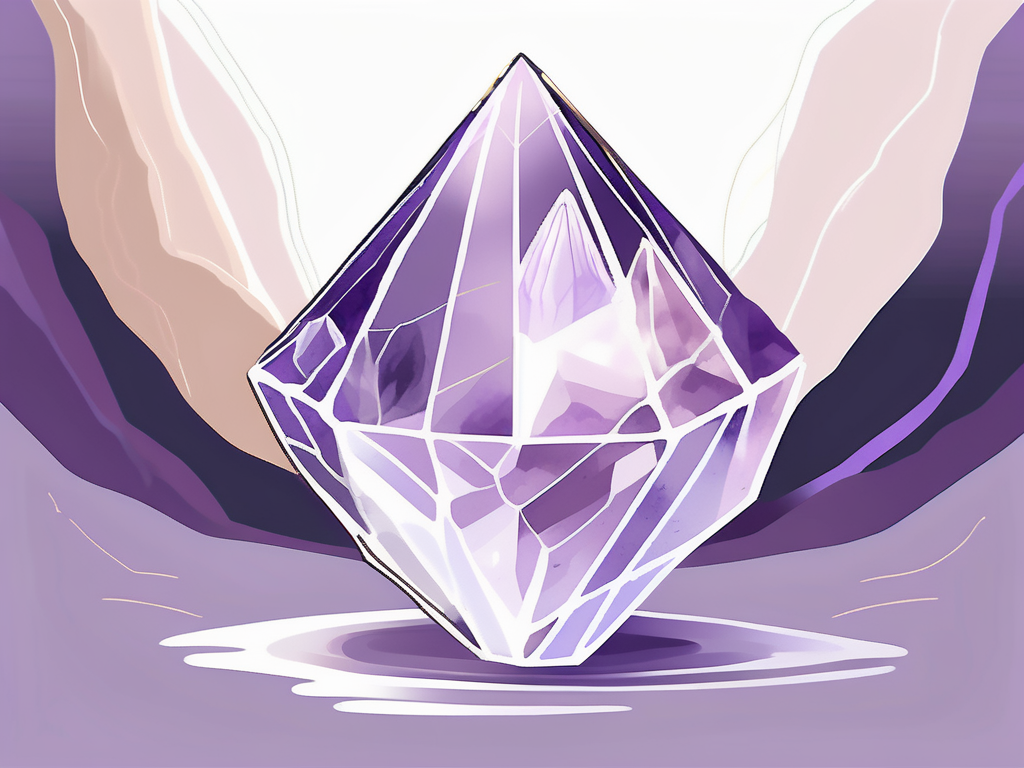Amethyst meaning, with its vibrant purple hue, has long been revered for its beauty and allure. But this gemstone holds a greater significance than meets the eye. In this article, we will delve into the historical, spiritual, and geological aspects of amethyst, exploring its rich symbolism, folklore, and various uses throughout the ages. Join us on this journey as we uncover the hidden meaning behind this captivating gem.
The Historical Significance of Amethyst meaning
Throughout history, amethyst has held a special place in the hearts and minds of civilizations around the world. From ancient times to the medieval era, this gemstone has been cherished for its unique properties. Let us take a glimpse into the past and discover the role amethyst played in different cultures.

Ancient Civilizations and Amethyst
In ancient civilizations, amethyst was regarded as a gem of great importance. The Egyptians believed it had protective powers, while the Greeks associated it with the god Dionysus and believed it could ward off intoxication. This association with sobriety made amethyst highly sought after among the elite.
Meanwhile, the Romans believed that wearing amethyst would prevent them from becoming drunk, and they even crafted drinking vessels adorned with this gemstone. They believed that the amethyst's color represented wine diluted with water, symbolizing moderation and wisdom.
Amethyst's connection to royalty was also evident during this period. Kings and queens adorned themselves with amethyst jewelry, symbolizing power and authority. These gemstones were often featured in crowns, scepters, and other regal ornaments.
But the significance of amethyst extended beyond its association with sobriety and royalty. It was also believed to possess healing properties and promote clarity of mind. Ancient civilizations used amethyst in medicinal practices, believing that it could alleviate ailments such as headaches and insomnia. The gemstone was often worn as an amulet or placed under pillows to enhance its healing effects.
Amethyst meaning in Medieval Times
During the medieval era, amethyst continued to hold its mystical allure. It was believed to possess healing properties and protect its wearer from harm. Many medieval church leaders adorned themselves with amethyst, associating its purifying qualities with spirituality and divine connection.
Amethyst was also used in ecclesiastical decorations, adorning altars and religious artifacts. Its vivid hue symbolized transformation and higher consciousness. The gemstone's presence within churches was not only seen as aesthetically pleasing but also as a nod to its spiritual significance.
But amethyst's influence went beyond its use in religious settings. It was also highly valued in medieval courtly love traditions. Amethyst was seen as a symbol of fidelity and true love, and it was often exchanged between lovers as a token of their commitment. The gemstone was believed to strengthen the bond between two souls and bring harmony to their relationship.
As the centuries passed, amethyst's allure remained strong. Its rich history and symbolism continue to captivate people's imaginations, making it a gemstone that is cherished and treasured to this day.
The Spiritual and Metaphysical Properties of Amethyst
Beyond its historical significance, amethyst has long been associated with spiritual and metaphysical properties. It is said to possess healing energies and a connection to the divine. Let us delve into its spiritual significance and explore how it has been utilized in various practices.

Amethyst in Healing and Meditation
Amethyst is believed to promote inner peace, balance, and healing. Its calming energy is said to alleviate stress, anxiety, and emotional turmoil. Many individuals turn to amethyst during meditation to enhance their spiritual experiences and promote clarity of thought.
Practitioners of alternative medicine often recommend amethyst to aid in physical and emotional healing. It is believed to purify the body, mind, and spirit, promoting overall well-being. From easing headaches to aiding in sleep, amethyst is considered a versatile and powerful healing stone.
The Chakra Connection of Amethyst
Amethyst is closely connected to the crown chakra, located at the top of the head. This energy center is associated with higher consciousness, spiritual growth, and enlightenment. The violet hue of amethyst resonates with this chakra, facilitating a deeper connection to the divine.
Amethyst's energetic properties are believed to open and activate the crown chakra, allowing for greater spiritual awareness and expanded consciousness. This connection to the crown chakra makes amethyst a valuable tool for those seeking spiritual growth and connection.
The Geology of Amethyst
While the historical and spiritual aspects of amethyst are fascinating, understanding its geology provides valuable insights into its formation and characteristics. Let us delve into the geological aspects of amethyst and discover the science behind its allure.
Formation and Locations of Amethyst Deposits
Amethyst is a variety of quartz, which forms in hexagonal prisms and often occurs in geodes or clusters. It is created through a combination of heat and pressure deep within the Earth's crust. Over time, these natural processes create the unique crystal structure and vibrant purple color that makes amethyst so sought after.
Amethyst deposits can be found in various locations around the world. Notable sources include Brazil, Uruguay, Zambia, and Russia. Each location produces amethyst with its own distinct characteristics, including varying shades of purple and unique inclusions.
Varieties and Characteristics of Amethyst meaning
Amethyst occurs in a range of hues, from light lilac to deep purple. Some specimens may also exhibit color zoning or have a gradient of shades within a single crystal. These variations in color can add to the appeal of amethyst, making each specimen unique and captivating.
Furthermore, amethyst can display pleochroism, meaning that it exhibits different colors when viewed from different angles. This optical phenomenon enhances the gemstone's beauty and adds depth to its appearance.
Amethyst in Art and Jewelry
Amethyst's allure extends beyond its historical and metaphysical significance. Its radiant purple color has made it a popular choice in both ancient and modern art and jewelry. Let us explore the various ways in which amethyst has been incorporated into artistic and ornamental creations.
Amethyst in Ancient and Modern Jewelry
Throughout history, amethyst has adorned the crowns, necklaces, and rings of the elite. Its regal purple hue has always been associated with luxury and opulence. Even today, amethyst continues to be highly prized in jewelry and is often used as a centerpiece gemstone.
Amethyst's versatility allows it to be incorporated into various jewelry designs, from delicate pendants to bold statement pieces. Its vibrant color contrasts beautifully with both precious metals and other gemstones, making it a favorite among jewelry designers and collectors alike.
Amethyst in Sculpture and Decorative Arts
In addition to its use in jewelry, amethyst has been utilized in sculpture and decorative arts throughout history. From ancient statuary to intricate vases and carvings, amethyst's unique beauty has been celebrated in various art forms.
Its captivating hue and metaphysical properties make amethyst a popular choice for decorative pieces. Whether as an amethyst crystal cluster displayed in a home or as a centerpiece in a sculpture, this gemstone adds an element of elegance and enchantment to any artistic creation.
The Symbolism and Folklore of Amethyst Meaning
Amethyst has been steeped in symbolism and folklore for centuries, each culture attributing its own unique beliefs and meanings to this gemstone. Let us dive into the symbolism and learn how amethyst has been perceived throughout different periods in history.
Amethyst in Mythology and Legends
In Greek mythology, amethyst is associated with the god Dionysus. According to the legend, Dionysus, the god of wine and celebration, had grown angry at mortals and vowed to unleash his tigers upon the next human who crossed his path. A young maiden named Amethyst was on her way to pay homage to the goddess Diana when she encountered Dionysus. Terrified, Amethyst called out to Diana for help, who turned her into a clear crystal to protect her from harm. Dionysus, overcome with remorse, wept tears of wine onto the crystal, staining it purple and creating the very first amethyst.
Amethyst's association with sobriety and protection from intoxication can also be traced back to Greek mythology. Many ancient Greeks believed that wearing or drinking from vessels made of amethyst would prevent them from becoming drunk.
Modern Symbolism and Beliefs about Amethyst meaning
In modern times, amethyst has come to symbolize clarity of mind, spiritual growth, and protection from negative energies. It is believed to enhance intuition, bring peace and calmness, and promote a deeper connection to one's inner self.
Some individuals also attribute specific properties to different shades of amethyst. Lighter shades are associated with purity and spiritual awakening, while deeper shades are believed to promote intuition and spiritual wisdom.
In metaphysical and New Age practices, amethyst is often used as a tool for spiritual cleansing and creating a protective energy shield around oneself. Its ability to absorb and transmute negative energies is highly valued in these belief systems.
In Conclusion
Amethyst, with its rich history, spiritual significance, and captivating beauty, is much more than a gemstone. It is a symbol of power, wisdom, and transformation. From ancient civilizations to modern beliefs, amethyst has held a special place in the hearts and minds of individuals seeking spiritual connection and personal growth. Explore our amethyst collection. View our blog for more deep dives on other crystals.

Whether admired for its vibrant purple color, cherished for its healing properties, or worn as a symbol of status and authority, amethyst continues to captivate and inspire. Its allure transcends time and culture, making it an enduring gemstone with a profound meaning that remains unveiled to those who seek its wisdom and beauty.

